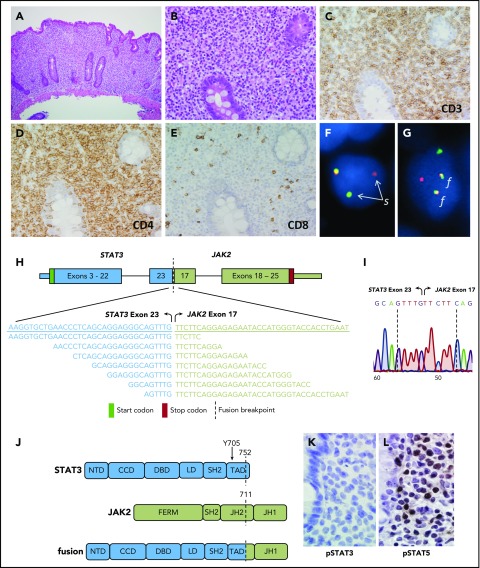Figure 1.
Indolent T-cell lymphoproliferative disorder of the gastrointestinal tract with STAT3-JAK2 fusion. (A-B) Duodenal biopsy shows a monotonous population of small lymphocytes in the lamina propria with preservation of the glands (hematoxylin and eosin stain; patient 2; original magnification ×40 [A] and ×400 [B]). By immunohistochemistry, the cells are positive for (C) CD3 and (D) CD4 and negative for (E) CD8 (original magnification ×400 [C-E]). (F) FISH using a break-apart probe to the JAK2 gene region shows separations of red and green signals, indicating the presence of a rearrangement (original magnification ×600). (G) FISH using a dual-fusion probe for the STAT3 (red) and JAK2 (green) gene regions shows red-green fusion signals (f), indicating the presence of fusion of these 2 regions (original magnification ×600). (H) RNA sequencing identifies chimeric reads supporting the presence of STAT3-JAK2 fusion joining the end of exon 23 of STAT3 with the beginning of exon 17 of JAK2. The identical breakpoint was found in all 3 patients who had GI TLPD with STAT3-JAK2 fusion whose samples were successfully sequenced. (I) Sanger sequencing confirms the STAT3-JAK2 breakpoint identified by RNA sequencing. (J) Protein domain structure of STAT3, JAK2, and predicted STAT3-JAK2 fusion protein. The amino acid numbers at the breakpoints are shown as well as the location of STAT3Y705. Using immunohistochemistry showed that the cells lack staining for (K) pSTAT3Y705 but are positive for (L) pSTAT5Y694 (patient 2; original magnification ×1000). CCD, coiled coil domain; DBD, DNA binding domain; FERM, four-point-one, ezrin, radixin, moesin homology domain; JH1, JAK homology 1 (tyrosine kinase) domain; JH2, JAK homology 2 (pseudokinase) domain; LD, linker domain; NTD, N-terminal domain; SH2, Src homology 2 domain; TAD, transcription activation domain.

